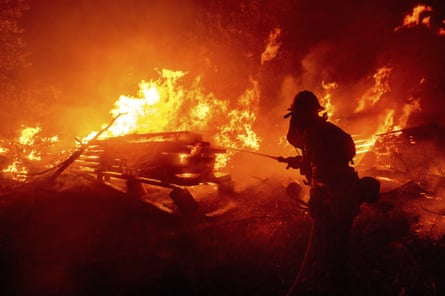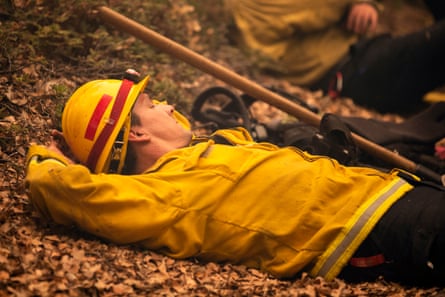Extract from The Guardian

Fatigue and strain sets in as crews face multiple challenges: Covid, civil unrest, a political year and record-breaking fires
Last modified on Wed 16 Sep 2020 05.08 AEST
It was always going to be a hard year for California’s firefighters. Even before freak summer lightning storms lit up the state weeks earlier than expected and Covid-19 and the climate crisis became dueling calamities, fire crews were bracing for a season of record-breaking infernos across the west.
Now, fatigued first responders are facing fires that are burning hotter, faster and more frequently than ever before – and it’s only expected to get worse as the season goes on. The strain is already starting to set in.
“I have never seen something at this level,” said James Bowron, Oakland fire department’s battalion chief. In nearly three decades on the job, he has never witnessed this many fires burning at once.
California saw a fierce and early start to its annual fire season. By the first week of September, a record 3.3m acres had gone up in flames. That’s 26 times more than the area that had burned last year by this time. Firefighters are battling nearly 30 major blazes. Officials report that roughly 4,900 structures have been reduced to rubble and 24 people have lost their lives. The victims include Diana Jones, an emergency medical technician volunteering on the firefight in Tehama.
More than 14,800 first responders are out fighting to contain the fires, according to state officials. “That’s a lot,” said Christine McMorrow, a resource management communication officer with Cal Fire, “that’s everybody we’ve got.”
The unprecedented scope and intensity caused by the explosion of simultaneous fires has crews spread thin. Covid has added further complications, with infections and quarantine requirements limiting aid from other states and the number of crews that otherwise might have been able to deploy.

“This is taxing the system and getting to the point where we have maybe come close to breaking the mutual aid system or tapping it out completely,” said Bowron. When there’s no more aid coming, it means longer, more frequent deployments for in-state firefighters who go and for those who stay to cover the stations back home.
California also typically relies on inmate crews to help work wildland fires but many have been under lockdown or quarantine because of Covid-19 outbreaks in state prisons. McMorrow says they are two crews short as a result.
Bowron had only recently returned from a 14-day stint fighting the SCU Lightning Complex fire that started on 18 August and burned through nearly 400,000 acres, and has now been deployed to lead a strike team at the El Dorado fire in San Bernardino.
“Covid and homeschool are an added additional stress,” he said. His wife works as a nurse at a hospital, and they have three young daughters stuck at home. “You make phone calls home and the kids are like, ‘Daddy, when are you coming home?’ It does get hard. Your children get used to disappointment,” he said.
“My girls are getting older now and I have been doing this for a long time and we have always been very honest with them. They understand that there is sacrifice that has to be made by our family to help keep other families safe and that it’s important for society to continue – but it is not easy to leave”.
‘This year has been rough for everybody’
It’s not just the amount of fires burning at one time and the shortage of firefighters on hand to combat them – the fires themselves are getting harder to fight.
With some fires encroaching on residential neighborhoods and others on remote areas where people who have left the cities amid Covid-19 have fled, wildland crews trained to contain the flames have had to shift focus to save lives instead of properties and acreage.
“We are having to run up to a fire, and then the assignments are not to protect structures or start fire attack – it is to get people out,” says Vince Wells, a former fire chief who served Contra Costa county where the SCU Lightning Complex fire erupted in mid-August. Wells retired recently but is still serving a two-year term as the local firefighters union president and the vice-president of California Professional Firefighters, an organization with more than 30,000 members. He hears first-hand experiences from firefighters and chiefs across the state.
“Times are unprecedented. Unfortunately it is not over,” Wells added. “It used to be that you thought about fires from May till maybe October. But now, we are fighting fires on Christmas Day or into the next year.”

Warmer and drier conditions are expected through December in California this year, according to the US National Interagency Coordination Center, and this month’s incidents are just the start of a “significant fall fire season”. Crews are in for a long fight.
“This year has been rough for everybody,” said Dr Mynda Ohs, a mental health clinician who works with first responders. “Covid, civil unrest, a political year, people losing businesses and money. That is just regular life, and then you add fire season and firefighter stuff – they have to come fight fires while their families are still dealing with that.”
She intimately knows the toll it takes, as her husband is a battalion chief. He had just returned from a 26-day deployment when she was sent to the fire line to help assist a team of 14 firefighters who had been trapped in the flames. They had to deploy their last-resort fire shelters, small foldable fire-resistant tents firefighters can climb into when there’s no way out. They survived, some with serious injuries.
Stationed under darkened smoky skies in camp near the Dolan fire, she said many firefighters came into this fight already stressed. “Because of what is going on in our personal lives, people are coming into this season tapped out. And then you have these record fires that are moving quickly, our resources are spread so thin, they are waiting for out-of-state resources, and some are left in a hairy situation.”
‘We know what we signed up for’
Camp life has also changed. To try to contain the spread of Covid-19 among crews and staff, everyone is trying to keep their distance. There are hand-sanitizing stations, food is distributed in containers instead of through a buffet line, temperatures are taken regularly, and masks are mandatory when around others. The adjustments themselves aren’t the problem, but they impact the teams’ peer-support system. “Sitting around the dinner table, sitting around camp – but that has been removed because of Covid. People have to eat off by themselves. They are losing the natural support system they have,” Ohs said.
Even with the precautions taken, firefighters across the state have fallen ill. At one point in March, more than 10% of San Jose’s entire firefighting staff was exposed to Covid-19. One firefighter with the Los Angeles fire department died after falling ill with the virus.
Firefighter Edward Gonzalez, a 36-year-old apparatus operator stationed in Van Nuys, California, contracted the virus in June, and spread Covid-19 to his wife who is now eight months pregnant. They both recovered quickly, and he was eager to get back to work. He’s thankful to have a job.

“For us right now we are fortunate to be able to work so much. I know next year the city is going to have a budget shortage and a lot of things could be cut,” Edward said, explaining why he picks up extra shifts with a smile. He added that starting his career during the Great Recession in 2008 he saw a lot of firefighters lose their jobs and homes. He’s worried it could happen again if city budgets are cut next year. “I could see that happening to us – so I am trying to prepare us and our family.”
At the state level, the California governor, Gavin Newsom, listed firefighting among his top priorities, and included $85.7m in his latest budget to help with surge capacity. The funding is the first phase of his plan to bring on 600 more Cal Fire firefighters over the next five years. Still, as cities tighten their belts, local stations could see cuts, adding even more pressure put on crews each year as fires get worse.
Ohs said a shift in mental health support is long overdue but badly needed. The stigma of seeking help has only started to fade in the last three to five years, in response to what some consider a growing mental health crisis in the dangerous profession.
This year, Newsom also signed two bills that support firefighters’ mental health. Senate Bill 542 ensures post-traumatic stress injury protection through workers’ compensation, and Assembly 1116 establishes training guidelines for peer counseling and protects confidentiality of those who seek behavioral health services.
Even with more challenging conditions, firefighters aren’t backing down from the fight. “I know people are being pushed to limits,” Wells said. “We are dealing with the heat, on top of a pandemic, on top of the large number of fires and the shortness of resources.”
But, he knows crews will continue to rise to the challenge as long as they are asked to. “We know what we signed up for,” he said. “When we swear in to serve our community that is what everyone is committed to do, to the best of their ability.”
No comments:
Post a Comment